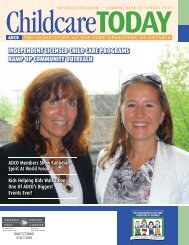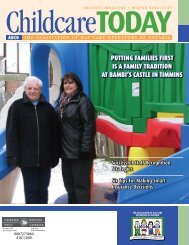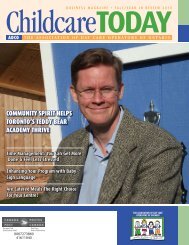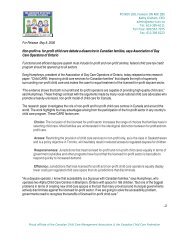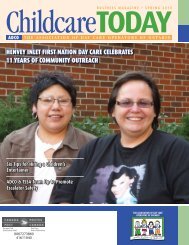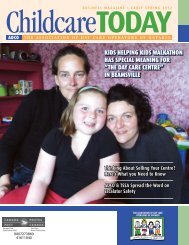discovery child care in barrie earns international recognition for ...
discovery child care in barrie earns international recognition for ...
discovery child care in barrie earns international recognition for ...
You also want an ePaper? Increase the reach of your titles
YUMPU automatically turns print PDFs into web optimized ePapers that Google loves.
Ontario’s Child<strong>care</strong> IndustryHealth, Safety & NutritionFOR A HEALTHIER DIET, JUST ADD WATERBy: Maria Dicresce-Niles, Nutritionist, Food For Tots.with files from www.Healthylicious.caWhen summer is <strong>in</strong> full sw<strong>in</strong>g and the weather ishot and humid, it’s easy to remember to makesure young <strong>child</strong>ren stay hydrated and getenough fluids dur<strong>in</strong>g the day. On cooler days, it’s easy to<strong>for</strong>get, but it is just as important, because <strong>child</strong>ren maybe more <strong>in</strong>cl<strong>in</strong>ed to be active. Many young <strong>child</strong>ren loveto dr<strong>in</strong>k juice and milk, which is great, but water is thebest way <strong>for</strong> both <strong>child</strong>ren and adults to stay hydrated.Water is very important <strong>for</strong> our bodies because it is vital<strong>for</strong> bodily functions – it carries waste away <strong>in</strong> ur<strong>in</strong>e andallows sweat<strong>in</strong>g to cool the body temperature down. Thebonus is that it doesn’t conta<strong>in</strong> any empty calories, so itis a safe and wise choice <strong>for</strong> all <strong>child</strong>ren.When <strong>child</strong>ren are small, it can be tricky to tell ifthey’re gett<strong>in</strong>g enough water. Usually by the time ayoung <strong>child</strong> says he or she is thirsty, a level of dehydrationmay already be beg<strong>in</strong>n<strong>in</strong>g to occur. It’s also importantto understand that young <strong>child</strong>ren feel th<strong>in</strong>gs differentlythan adults, so they cannot always tell they are thirsty.Children may perspire very little or not at all, so parentsand <strong>care</strong>givers need to be aware of the warn<strong>in</strong>g signsthat a <strong>child</strong> may be dehydrated. Some of the earlysigns <strong>in</strong>clude sleep<strong>in</strong>ess and lack of energy, irritability,cry<strong>in</strong>g, dry lips or tongue, constipation, sunken eyes ora sunken fontanel – the soft spot on top of the head ofnewborns. If you or a parent are ever concerned that ayoung <strong>child</strong> is dehydrated, yet will not dr<strong>in</strong>k anyth<strong>in</strong>g,contact a doctor or pediatrician immediately.You may also wish to share with parents this easyway to tell if a <strong>child</strong> needs to dr<strong>in</strong>k more water as partof his or her daily rout<strong>in</strong>e. Tell parents to pay attentionto the colour of their <strong>child</strong>’s ur<strong>in</strong>e. If it is dark yellow, itusually means the <strong>child</strong> is not gett<strong>in</strong>g enough water.Ideally, it should be colourless or a very light yellow andthere should be no odour.In addition to encourag<strong>in</strong>g their <strong>child</strong>ren to dr<strong>in</strong>kmore water, parents can make a po<strong>in</strong>t of <strong>in</strong>clud<strong>in</strong>g waterrichfoods <strong>in</strong> <strong>child</strong>ren’s diets. Many fruits and vegetablesare high <strong>in</strong> water. Cantaloupes and apples are 85% water,sp<strong>in</strong>ach is 90% water and lettuce is 95% water. Milk is agood source of water s<strong>in</strong>ce it conta<strong>in</strong>s 88% water. Parentscan also add water to <strong>child</strong>ren’s fruit juice. A mix that is50% to 75% water can provide enough fruit flavour toentice <strong>child</strong>ren who don’t like dr<strong>in</strong>k<strong>in</strong>g straight water.Parents may also try offer<strong>in</strong>g <strong>child</strong>ren seasonalbeverage options, such as frozen juice popsicles <strong>in</strong> thesummer and warm apple cider <strong>in</strong> w<strong>in</strong>tertime. Mostsupermarkets sell fresh-pressed apple cider <strong>in</strong> theproduce department. It’s naturally sweet, packed withvitam<strong>in</strong>s and can be made a special treat by add<strong>in</strong>g ap<strong>in</strong>ch of c<strong>in</strong>namon.NO MATTER WHAT THE WEATHER,BE HYDRATION-WISEChildren who are underweight or obese aremore susceptible to dehydration.Some experts believe that low water <strong>in</strong>take andchronic mild dehydration can be contribut<strong>in</strong>g factorsto <strong>child</strong>hood and adolescent obesity, various<strong>for</strong>ms of illness and even some types of cancer.Beware of giv<strong>in</strong>g <strong>child</strong>ren sports dr<strong>in</strong>ks, whichtend to be high <strong>in</strong> sugar and calories. Althoughthey’re often marketed as an essential part ofathletic activity because of their electrolyte content,<strong>child</strong>ren may not need them <strong>in</strong> the quantities<strong>in</strong> which they are packaged. An eightounceserv<strong>in</strong>g is generally sufficient to meet thehydration needs of a <strong>child</strong> exercis<strong>in</strong>g at high<strong>in</strong>tensity <strong>for</strong> 90 m<strong>in</strong>utes.SUMMER/BACK TO SCHOOL 2012 • Child<strong>care</strong>TODAY 17




